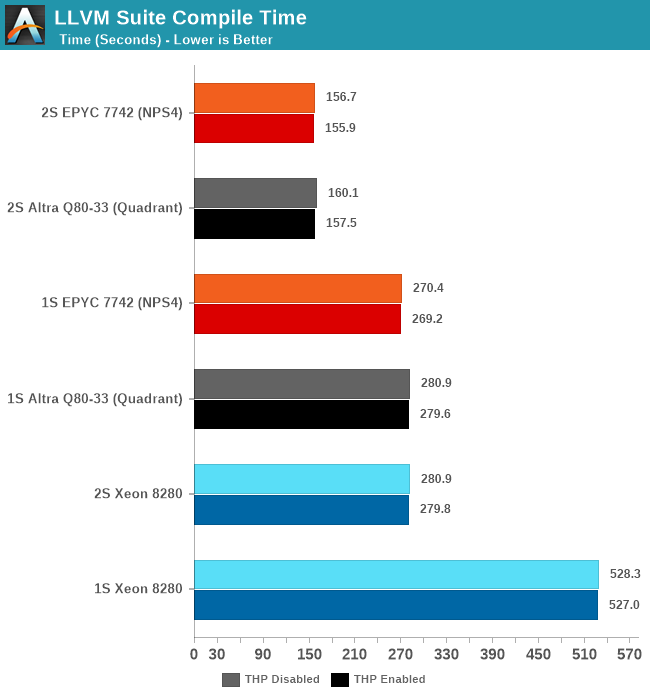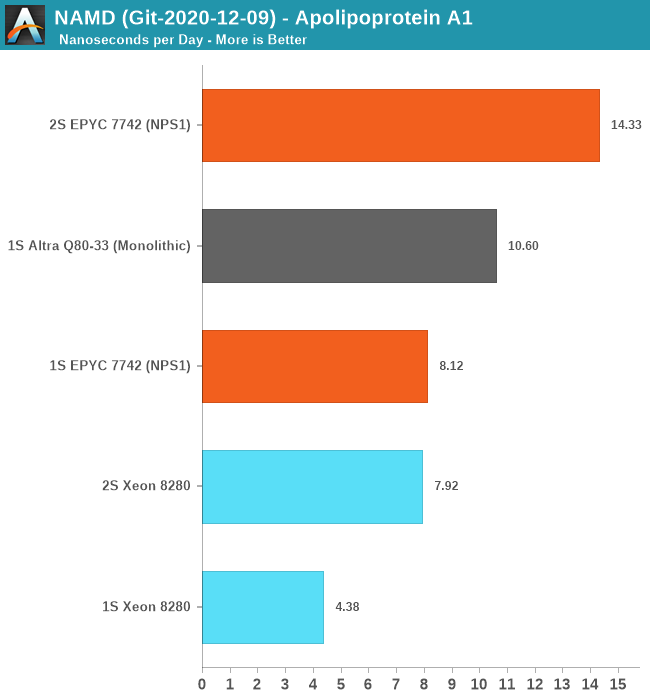The Ampere Altra Review: 2x 80 Cores Arm Server Performance Monster
by Andrei Frumusanu on December 18, 2020 6:00 AM EST- Posted in
- Servers
- Neoverse N1
- Ampere
- Altra
Compiling LLVM, NAMD Performance
As we’re trying to rebuild our server test suite piece by piece – and there’s still a lot of work go ahead to get a good representative “real world” set of workloads, one more highly desired benchmark amongst readers was a more realistic compilation suite. Chrome and LLVM codebases being the most requested, I landed on LLVM as it’s fairly easy to set up and straightforward.
git clone https://github.com/llvm/llvm-project.gitcd llvm-projectgit checkout release/11.xmkdir ./buildcd ..mkdir llvm-project-tmpfssudo mount -t tmpfs -o size=10G,mode=1777 tmpfs ./llvm-project-tmpfscp -r llvm-project/* llvm-project-tmpfscd ./llvm-project-tmpfs/buildcmake -G Ninja \ -DLLVM_ENABLE_PROJECTS="clang;libcxx;libcxxabi;lldb;compiler-rt;lld" \ -DCMAKE_BUILD_TYPE=Release ../llvmtime cmake --build .We’re using the LLVM 11.0.0 release as the build target version, and we’re compiling Clang, libc++abi, LLDB, Compiler-RT and LLD using GCC 10.2 (self-compiled). To avoid any concerns about I/O we’re building things on a ramdisk – on a 4KB page system 5GB should be sufficient but on the Altra’s 64KB system it used up to 9.5GB, including the source directory. We’re measuring the actual build time and don’t include the configuration phase as usually in the real world that doesn’t happen repeatedly.

The Altra Q80-33 here performs admirably and pretty much matches the AMD EPYC 7742 both in 1S and 2S configurations. There isn’t exact perfect scaling between sockets because this being a actual build process, it also includes linking phases which are mostly single-threaded performance bound.
Generally, it’s interesting to see that the Altra here fares better than in the SPEC 502.gcc_r MT test – pointing out that real codebases might not be quite as demanding as the 502 reference source files, including a more diverse number of smaller files and objects that are being compiled concurrently.
NAMD
Another rather popular benchmark tool that we’ve actually seen being used by vendors such as AMD in their marketing materials when showcasing HPC performance for their server chips is NAMD. This actually quite an interesting adventure in terms of compiling the tool for AArch64 as essentially there little to no proper support for it. I’ve used the latest source drop, essentially the 2.15alpha / 3.0alpha tree, and compiled it from scratch on GCC 10.2 using the platform’s respective -march and -mtune targets.
For the Xeon 8280 – I did not use the AVX512 back-end for practical reasons: The code which introduces an AVX512 algorithm and was contributed by Intel engineers to NAMD has no portability to compilers other than ICC. Beyond this being a code-path that has no relation with the “normal” CPU algorithm – the reliance on ICC is something that definitely made me raise my eyebrows. It’s a whole other discussion topic on having a benchmark with real-world performance and the balance of having an actual fair and balanced apple to apples comparison. It’s something to revisit in the future as I invest more time into looking the code and see if I can port it to GCC or LLVM.

For the single-socket numbers – we’re using the multicore variant of the tool which has predictable scaling across a single NUMA node. Here, the Ampere Altra Q80-33 performed amazingly well and managed to outperform the AMD EPYC 7742 by 30% - signifying this is mostly a compute-bound workload that scales well with actual cores.
For the 2S figures, using the multicore binaries results in undeterministic performance – the Altra here regressed to 2ns/day and the EPYC system also crashed down to 4ns/day – oddly enough the Xeon system had absolutely no issue in running this properly as it had excellent performance scaling and actually outperforms the MPI version. The 2S EPYC scales well with the MPI version of the benchmark, as expected.
Unfortunately, I wasn’t able to compile an MPI version of NAMD for AArch64 as the codebase kept running into issues and it had no properly maintained build target for this. In general, I felt like I was amongst the first people to ever attempt this, even though there are some resources to attempt to help out on this.
I also tried running Blender on the Altra system but that ended up with so many headaches I had to abandon the idea – on CentOS there were only some really old build packages available in the repository. Building Blender from source on AArch64 with all of its dependencies ends up in a plethora of software packages which simply assume you’re running on x86 and rely on basic SSE intrinsics – easy enough to fix that in the makefiles, but then I hit some other compilation errors after which I lost my patience. Fedora Linux seemed to be the only distribution offering an up-to-date build package for Blender – but I stopped short of reinstalling the OS just to benchmark Blender.
So, while AArch64 has made great strides in the past few years – and the software situation might be quite good for server workloads, it’s not all rosy and we’re still have ways to go before it can be considered a first-class citizen in the software ecosystem. Hopefully Apple’s introduction of Apple Silicon Macs will accelerate the Arm software ecosystem.










148 Comments
View All Comments
tygrus - Saturday, December 19, 2020 - link
Next step would be to see how ARM performed with 256MB (or more) of cache. The early models didn't suit many workloads compared to the general purpose kings (x86-64). Each generation of ARM based server chips have seen an increase to the number of suitable workloads thus more general purpose. Adding more specialised instructions to x86 has diminishing returns that increase the complexity of decoding & execution it's always good to be challenged "can we make it simpler & faster?".mode_13h - Sunday, December 20, 2020 - link
ARM has been doing some of the same, though. Look at the evolution of ARMv8-A as it has aged, and you'll see several bolt-ons to target additional markets:* new atomics
* signed, saturating multiplies
* CRC instructions
* half-precision floating point
* SVE (their answer to AVX/AVX-512)
* complex number support
* an instruction specifically for floating-point conversion in Javascript
* integer dot products
* random number generation
* matrix multiply & manipulation
* BFloat16 support
* a smattering of other virtualization and security-oriented additions
That's not a small list, and definitely not a less-is-more approach.
Leeea - Sunday, December 20, 2020 - link
Very interesting.Great article.
Sivar - Sunday, December 20, 2020 - link
Typo report, conclusion: "The se*ver landscape is changing very quickly. "Sivar - Sunday, December 20, 2020 - link
Imagine the response if someone made a prediction of this statement just five years ago:"Intel’s current Xeon offering simply isn’t competitive in any way or form at this moment in time. Cascade Lake is twice as slow and half as efficient – so unless Intel is giving away the chips at a fraction of a price, they really make no sense."
mode_13h - Sunday, December 20, 2020 - link
Heh, good call!Makste - Monday, December 21, 2020 - link
Truly exciting times. Thanks for the review.There's going to be a massive restructuring in "computeverse".
I hope they'll be a merger at one point.
hyc - Monday, December 21, 2020 - link
It would've been more appropriate to compare Q64-33 to AMD to assess the merits of each architectural design. Could you repeat some of these tests, limiting the Altra to only 64 cores/threads?Wilco1 - Tuesday, December 22, 2020 - link
It might be an interesting comparison with SMT disabled since the extra 25% of cores are the alternative to adding SMT. However should we also limit EPYC to 32MB L3 to make things more equal?hyc - Friday, December 25, 2020 - link
Are you saying that turning off 16 cores in the Q80-33 is not the equivalent of running a Q64-33?Turning off SMT may have some merits, depending on workload.